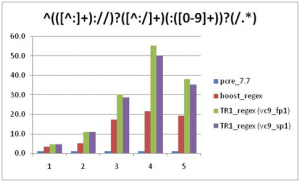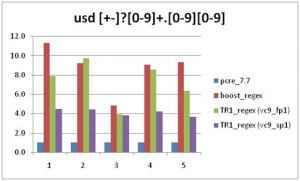Graphviz is an excellent and free graph visualization program that provides a simple way to generate graphs for pretty much anything with a variety of layouts. The Graphviz layout programs take descriptions of graphs in a simple text language. These descriptions can be created and edited manually but are more usually generated programatically – especially for large data sets.
This post provides an example of using the Visitor pattern to generate a directed graph visualization of a trie using the Graphviz dot layout manager. Full python source code listing of this example is available here.
A Trie class is used to represent the trie data structure. This class is composed of a set of nodes representing the trie nodes. These nodes are anchored via a root node. The code for adding data to the trie is omitted for clarity but is available in the full source listing.
class Trie:
def __init__(self):
self.root = Node()
def walk(self, visitor):
self.root.walk(visitor)
From a visitor pattern perspective, the Node.walk() method is used to traverse the nodes and to pass each node encountered to the visitor object.
class Node:
def walk(self, visitor):
visitor.visitNode(self)
for nextNode in self.children.values():
nextNode.walk(visitor)
The GraphvizVisitor class is a Visitor subclass that generates the appropriate dot language representation for each visited node.
# Visitor interface
class Visitor:
def visitNode(self, node):
pass
# Visitor subclass that generates Graphviz dot file contents.
class GraphvizVisitor:
def __init__(self, dotGen):
self.dotGen = dotGen
def visitNode(self, node):
if node.isOutputNode:
dotGen.setNodeProperty(node.name, 'shape', 'doublecircle')
for edge, nextNode in node.children.items():
dotGen.addLink(node.name, nextNode.name, edge)
The dotGen object is an instance of the DotFileGenerator class which is used as a simple utility class to generate the dot file.
class DotFileGenerator:
def __init__(self, name):
self.name = name
self.outf = open(name+'.dot', 'w')
print >> self.outf, 'digraph %s {' % (self.name)
print >> self.outf, 'trankdir="LR";'
print >> self.outf, 'tnode [shape = "circle"];'
def setNodeProperty(self, nodeName, property, value):
print >> self.outf, 't%s [%s = %s];' %(nodeName, property, value)
def addLink(self, lhs, rhs, label):
print >> self.outf, 't%s -> %s [label = %s];' % (lhs, rhs, label)
def close(self):
self.outf.close()
Consider the following example to illustrate the generated output:
# Build a trie
trie = Trie()
trie.addPattern("abc")
trie.addPattern("abcdef")
trie.addPattern("abcxyz")
trie.addPattern("abdef")
# Generate the dot file contents by walking the trie
dotGen = DotFileGenerator('trie')
visitor = GraphvizVisitor(dotGen)
trie.walk(visitor)
dotGen.close()
This produces the following dot file contents:
digraph trie {
rankdir="LR";
node [shape = "circle"];
0 -> 1 [label = a];
1 -> 2 [label = b];
2 -> 3 [label = c];
2 -> 10 [label = d];
3 [shape = doublecircle];
3 -> 7 [label = x];
3 -> 4 [label = d];
7 -> 8 [label = y];
8 -> 9 [label = z];
9 [shape = doublecircle];
4 -> 5 [label = e];
5 -> 6 [label = f];
6 [shape = doublecircle];
10 -> 11 [label = e];
11 -> 12 [label = f];
12 [shape = doublecircle];
}
After passing this dot file through Graphviz, we get:





